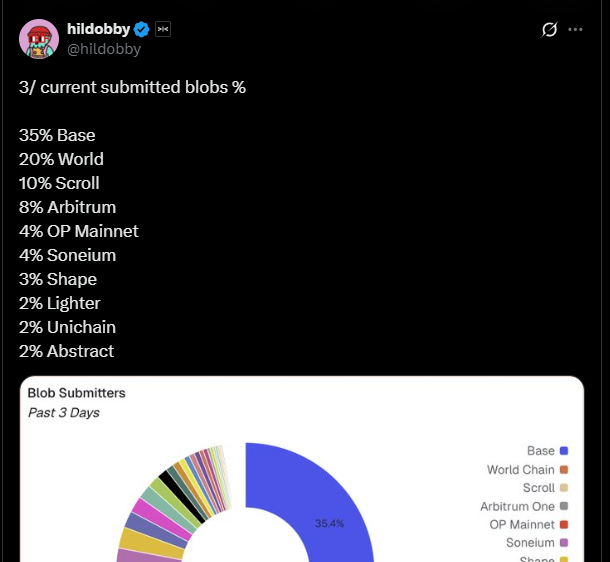TL;DR
- Vitalik Buterin says Fusaka's PeerDAS feature will be "the key to L2 scaling."
- PeerDAS lets nodes verify blockchain data without downloading everything.
- Ethereum will double blob capacity in December, boosting rollup performance.
- Data from Dragonfly shows blob usage hitting new highs, driven by Base and Worldcoin.
Ethereum's long-running scaling journey is about to hit another milestone. In a new post, co-founder Vitalik Buterin described how PeerDAS (Peer Data Availability Sampling) - a core part of December's Fusaka upgrade - could solve one of Ethereum's biggest bottlenecks: data availability.
Why PeerDAS Matters
Right now, Ethereum nodes have to download and verify a large amount of data to ensure the blockchain is valid. This limits throughput and makes scaling expensive.
PeerDAS changes that. Instead of every node downloading everything, each node only checks a small sample - "chunks" of data - while using statistics to confirm the network as a whole has the full dataset. This approach means Ethereum can support far more rollups (layer 2s) without overloading nodes. Rollups like Arbitrum, Optimism, and Base rely on Ethereum for data availability, and right now, that's where things get congested.
The Blob Factor
PeerDAS ties directly into blobs, the new data storage mechanism Ethereum introduced in the Dencun upgrade back in March 2024 (EIP-4844, also called proto-danksharding).
Blobs are special containers for temporary data - designed to make L2 transactions much cheaper by keeping their data separate from Ethereum's permanent state. On Wednesday, Ethereum hit a milestone: it reached its six blobs per block target for the first time. That observation came from Dragonfly's head of data, Hildebert Moulié, who pointed out that demand is being driven mainly by Coinbase's L2 Base and Worldcoin.

This spike shows that Ethereum's blob system is already being pushed to its limits - and why Fusaka is arriving just in time.
What Fusaka Will Do
Scheduled for December 3, 2025, Fusaka will introduce PeerDAS through EIP-7594 and also double blob capacity. Currently, blocks have a target of six blobs and a maximum of nine. After Fusaka, those numbers will increase, giving L2s more breathing room.
Buterin emphasized caution, noting this is still experimental tech.
Ethereum researcher Christine Kim has outlined the roadmap:
- December 2025 (Fusaka): blob max increases to 9.
- Early 2026 (First BPO fork): blob max rises to 15.
- January 2026 (Second BPO fork): blob max goes up to 21.
It's a phased rollout that ensures stability while scaling up capacity.
The Bigger Picture: Rollups and Costs
Why all this focus on blobs and PeerDAS? The answer is simple: costs.
Rollups, which batch thousands of transactions into Ethereum blobs, currently dominate Ethereum's scaling strategy. But the bottleneck has always been how much data L1 can handle. By making data availability more efficient, PeerDAS effectively removes the ceiling. More blobs mean lower transaction costs for L2 users, faster settlement, and less risk of congestion spikes during busy times.
This is especially crucial as mainstream-facing apps like Base and Worldcoin bring in new users who expect low fees and smooth UX.
What This Means for Users
For everyday users, the immediate impact might not be visible in December. But behind the scenes, Fusaka is setting the stage for:
- Cheaper transactions on rollups like Arbitrum, Optimism, Base, zkSync, and Starknet.
- More reliable performance even during peak demand.
- A path to full sharding in the years ahead, where Ethereum can scale natively at the base layer.
Closing Thoughts
Ethereum has spent years talking about scalability. With blobs already live and Fusaka bringing PeerDAS this December, those ideas are now materializing into real-world upgrades. If the rollout goes as planned, Fusaka could mark the beginning of a new chapter - one where Ethereum finally moves beyond bottlenecks and provides the foundation rollups need to thrive.
Or in Buterin's own words: "PeerDAS is the key to L2 scaling, and eventually L1 scaling.”
READ MORE : COTI V2’s Secret Weapon: Garbled Circuits Explained for the Web3 Era











